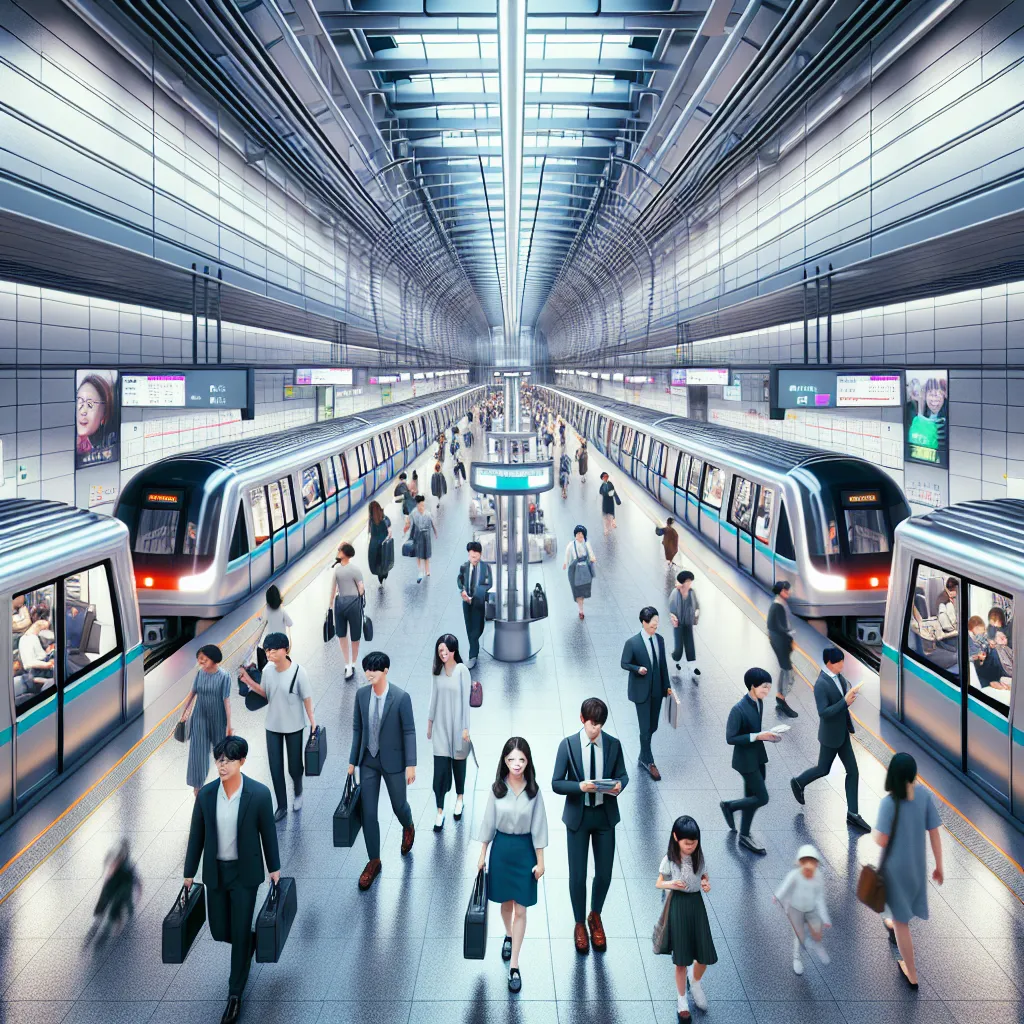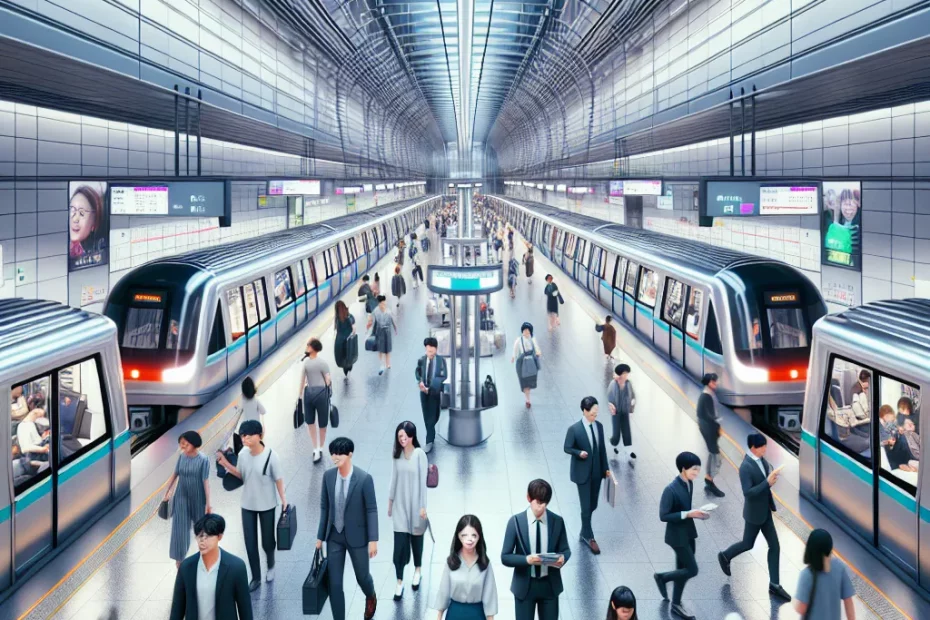Seoul’s super subway system is a marvel of modern transportation, seamlessly connecting the bustling city with efficiency and speed. As one of the largest and most advanced subway systems in the world, Seoul’s subway has revolutionized the way people travel, setting a high standard for urban public transportation globally. Managed with precision and foresight, this intricate network of lines and stations serves as a lifeline for millions of commuters daily, showcasing the city’s commitment to sustainable urban development. With ambitious expansion plans on the horizon, Seoul’s subway system continues to evolve, promising even greater convenience and accessibility for its residents and visitors alike.

The History of Seoul’s Subway System
In the bustling metropolis of Seoul, South Korea, lies a subway system that stands as a testament to modern engineering marvels. The history of Seoul’s subway system dates back to its humble beginnings in 1974, when Line 1 first opened its doors to the public. 🚇
Since then, the Seoul subway system has rapidly expanded to become one of the most extensive and efficient metro systems in the world. With over 300 stations covering a total length of more than 330 kilometers, the Seoul subway system serves as a lifeline for millions of commuters each day. 🏙️
The Introduction of Driverless Trains
The introduction of the world’s first driverless subway train on the Bundang Line in 2011 marked a significant technological advancement for Seoul’s subway system. This innovation not only improved efficiency but also solidified Seoul’s position as a pioneer in public transportation. 🚆
Seoul’s subway system is not just a means of transportation; it is a reflection of the city’s rapid growth and development over the decades. The sleek and modern design of the stations, coupled with state-of-the-art facilities, showcases Seoul’s commitment to providing a world-class commuting experience for its residents and visitors alike. 🌟
As Seoul continues to evolve and expand, so too does its subway system. With plans for additional lines and extensions in the works, the future of Seoul’s subway system looks brighter than ever. It is a shining example of how innovation and dedication can transform a city’s infrastructure and improve the lives of its citizens. 🌆
In conclusion, the history of Seoul’s subway system is a testament to the city’s unwavering commitment to progress and excellence. From its modest beginnings to its current status as a global leader in public transportation, Seoul’s subway system is a true symbol of innovation and efficiency. 🌟
So, the next time you find yourself in Seoul, take a ride on the subway and marvel at the engineering feat that is the Seoul subway system. It’s not just a mode of transportation; it’s a journey through the history and future of a vibrant city. 🌈
Advantages of Using Seoul’s Subway
When it comes to efficient and reliable public transportation systems, Seoul’s subway stands out as a shining example of excellence. With over 330 stations covering an extensive network of lines, the Seoul subway system offers a multitude of advantages that make it the preferred choice for millions of commuters every day. 🚇
Exceptional Punctuality
One of the key advantages of using Seoul’s subway is its exceptional punctuality. Trains in Seoul are known for their precise adherence to schedules, with an average delay of less than one minute. This level of reliability ensures that passengers can plan their journeys with confidence, knowing that they will reach their destinations on time. ⏱️
Impressive Speed and Efficiency
In addition to punctuality, the Seoul subway system boasts impressive speed and efficiency. With trains running at frequent intervals, passengers rarely have to wait long for the next train to arrive. The seamless connectivity between different lines further enhances the efficiency of the system, allowing commuters to travel across the city quickly and conveniently. 🚄
Cleanliness and Safety Standards
Moreover, the cleanliness and safety standards of Seoul’s subway are second to none. The stations and trains are meticulously maintained, creating a pleasant and hygienic environment for passengers. State-of-the-art security measures, including CCTV surveillance and emergency call points, ensure the safety of commuters at all times. 🧼
Affordability
Another significant advantage of using Seoul’s subway is its affordability. The fare structure is designed to be accessible to all, with discounted rates for students, seniors, and frequent travelers. This makes the subway an economical choice for daily commuting, especially when compared to the costs of owning and maintaining a private vehicle in the city. 💰
User-Friendly Amenities and Services
Furthermore, the Seoul subway system is renowned for its user-friendly amenities and services. From digital signage displaying real-time travel information to designated seating areas for the elderly and disabled, the system caters to the diverse needs of its passengers. Accessibility features such as elevators and ramps also make it easy for everyone to navigate the stations. 🚶♂️
In conclusion, the advantages of using Seoul’s subway are clear and compelling. From its exceptional punctuality and efficiency to its cleanliness, safety, affordability, and user-friendly services, the Seoul subway system sets a high standard for public transportation worldwide. For residents and visitors alike, choosing the Seoul subway is not just a practical decision but a smart one that enhances the overall quality of urban travel experience. 🏙️
How Seoul’s Subway System is Managed
Seoul’s subway system is a shining example of efficient and well-managed public transportation. With over 9 million daily riders, it is one of the busiest metro systems in the world. The management of such a vast network requires meticulous planning, advanced technology, and a dedicated team of professionals.
The Role of Technology
One key aspect of how Seoul’s subway system is managed is through the use of cutting-edge technology. The system is equipped with state-of-the-art signaling systems that ensure trains run on time with minimal delays. This technology allows for precise control of train movements, optimizing efficiency and passenger safety.
Strategic Planning and Coordination
In addition to technology, Seoul’s subway system is managed through strategic planning and coordination. The network consists of 23 lines spanning over 330 miles, connecting various parts of the city seamlessly. This extensive coverage is the result of careful planning to meet the needs of the growing population and alleviate traffic congestion.
Emphasis on Safety and Security
Furthermore, the management of Seoul’s subway system places a strong emphasis on safety and security. The stations are equipped with CCTV cameras, emergency call boxes, and trained staff to ensure the well-being of passengers. Regular maintenance checks and upgrades are also conducted to uphold safety standards and provide a comfortable riding experience.
Environmental Sustainability Efforts
Another crucial aspect of managing Seoul’s subway system is its environmental sustainability efforts. The system has implemented energy-efficient practices, such as LED lighting and regenerative braking systems, to reduce carbon emissions. This commitment to sustainability not only benefits the environment but also contributes to the overall well-being of the city’s residents.
Overall, the management of Seoul’s subway system is a testament to effective planning, technological innovation, and a commitment to passenger satisfaction. By prioritizing efficiency, safety, and sustainability, the system continues to set the standard for public transportation worldwide. Seoul’s subway system is not just a mode of transportation; it is a symbol of excellence in urban mobility. 🌟🚇🏙️
Future Expansion Plans for Seoul’s Subway
Seoul’s subway system, known for its efficiency and extensive coverage, is set to undergo significant expansion in the coming years. The Seoul Metropolitan Government has ambitious plans to further enhance the city’s transportation network, with a focus on improving connectivity, reducing congestion, and promoting sustainable urban development.
Line 9 Extension
One of the key projects in the pipeline is the extension of Line 9, which will connect the southeastern part of the city to the western districts. This extension will not only provide residents with more convenient access to public transportation but also stimulate economic growth in the surrounding areas. The construction is expected to be completed by 2023, adding approximately 12 kilometers to the existing line.
New Line 11 Construction
In addition to the Line 9 extension, there are plans to construct a new Line 11, which will run in a circular route around the outskirts of Seoul. This circular line will serve as a crucial link between existing subway lines, allowing passengers to transfer more easily and reducing travel times for those commuting between different parts of the city. The new Line 11 is projected to be operational by 2025, with an estimated length of 60 kilometers.
Introduction of Driverless Trains
Furthermore, the Seoul Metropolitan Government is exploring the possibility of introducing driverless trains on certain subway lines to improve efficiency and safety. By implementing cutting-edge technology, Seoul aims to stay at the forefront of public transportation innovation and provide passengers with a more comfortable and reliable commuting experience. The introduction of driverless trains is expected to begin on a trial basis in the next few years, with the potential for expansion to other lines in the future.
In conclusion, the future expansion plans for Seoul’s subway system demonstrate the city’s commitment to sustainable urban development and improving the overall quality of life for its residents. With new lines, extensions, and innovative technologies on the horizon, Seoul is poised to remain a global leader in public transportation for years to come. Let’s look forward to a more connected and efficient Seoul subway system! 🌟🚇
Seoul’s super subway system is a testament to the city’s commitment to efficient and sustainable urban transportation. With a rich history, well-managed operations, and ambitious expansion plans, it stands as a model for other cities around the world. The advantages of using Seoul’s subway, from convenience to environmental benefits, make it a preferred choice for millions of commuters daily. As the city continues to innovate and expand its network, the future looks bright for Seoul’s subway system. Its success serves as a shining example of how strategic planning and investment in public transportation can transform a city for the better.
